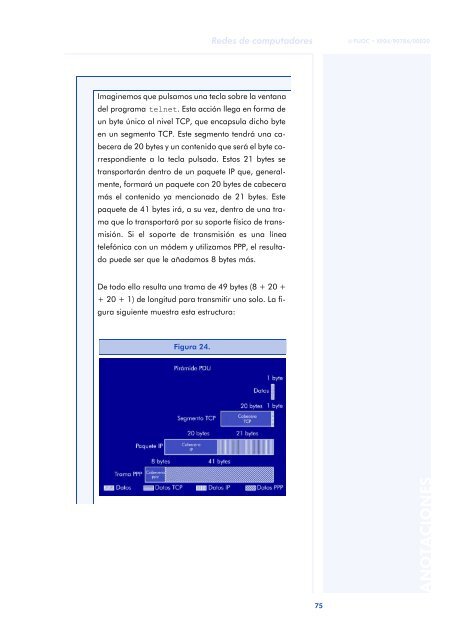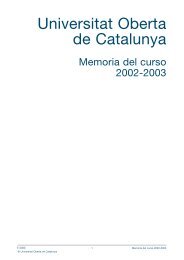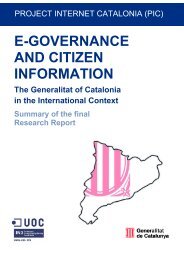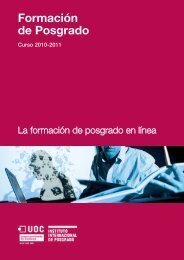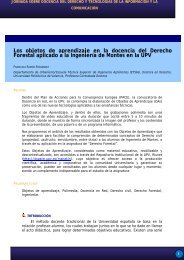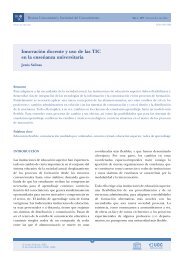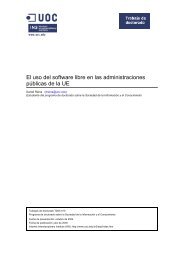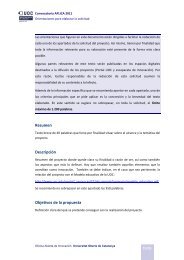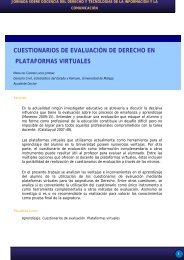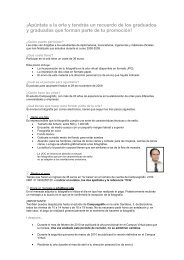- Page 1 and 2:
Software libreJosé María Barceló
- Page 3 and 4:
Redes de computadoresª FUOC • XP
- Page 5 and 6:
Redes de computadoresª FUOC • XP
- Page 7:
Redes de computadoresª FUOC • XP
- Page 11 and 12:
Redes de computadoresª FUOC • XP
- Page 13:
Redes de computadoresª FUOC • XP
- Page 17:
I. Introducción a las redesde comp
- Page 20 and 21:
ª FUOC • XP04/90786/00020Softwar
- Page 22 and 23:
ª FUOC • XP04/90786/00020Softwar
- Page 24 and 25: ª FUOC • XP04/90786/00020Softwar
- Page 26 and 27: ª FUOC • XP04/90786/00020Softwar
- Page 28 and 29: ª FUOC • XP04/90786/00020Softwar
- Page 30 and 31: ª FUOC • XP04/90786/00020Softwar
- Page 32 and 33: ª FUOC • XP04/90786/00020Softwar
- Page 34 and 35: ª FUOC • XP04/90786/00020Softwar
- Page 36 and 37: ª FUOC • XP04/90786/00020Softwar
- Page 39 and 40: Redes de computadoresª FUOC • XP
- Page 41 and 42: Redes de computadoresª FUOC • XP
- Page 43 and 44: Redes de computadoresª FUOC • XP
- Page 45 and 46: Redes de computadoresª FUOC • XP
- Page 47: Redes de computadoresª FUOC • XP
- Page 51 and 52: Redes de computadoresª FUOC • XP
- Page 53: Redes de computadoresª FUOC • XP
- Page 56 and 57: ª FUOC • XP04/90786/00020Softwar
- Page 58 and 59: ª FUOC • XP04/90786/00020Softwar
- Page 61 and 62: Redes de computadoresª FUOC • XP
- Page 63: Redes de computadoresª FUOC • XP
- Page 66 and 67: ª FUOC • XP04/90786/00020Softwar
- Page 68 and 69: ª FUOC • XP04/90786/00020Softwar
- Page 71 and 72: Redes de computadoresª FUOC • XP
- Page 73: Redes de computadoresª FUOC • XP
- Page 78 and 79: ª FUOC • XP04/90786/00020Softwar
- Page 80 and 81: ª FUOC • XP04/90786/00020Softwar
- Page 82 and 83: ª FUOC • XP04/90786/00020Softwar
- Page 84 and 85: ª FUOC • XP04/90786/00020Softwar
- Page 86 and 87: ª FUOC • XP04/90786/00020Softwar
- Page 88 and 89: ª FUOC • XP04/90786/00020Softwar
- Page 90 and 91: ª FUOC • XP04/90786/00020Softwar
- Page 92 and 93: ª FUOC • XP04/90786/00020Softwar
- Page 94 and 95: ª FUOC • XP04/90786/00020Softwar
- Page 96 and 97: ª FUOC • XP04/90786/00020Softwar
- Page 98 and 99: ª FUOC • XP04/90786/00020Softwar
- Page 101 and 102: Redes de computadoresª FUOC • XP
- Page 103 and 104: Redes de computadoresª FUOC • XP
- Page 105 and 106: Redes de computadoresª FUOC • XP
- Page 107 and 108: Redes de computadoresª FUOC • XP
- Page 109: Redes de computadoresª FUOC • XP
- Page 112 and 113: ª FUOC • XP04/90786/00020Softwar
- Page 114 and 115: ª FUOC • XP04/90786/00020Softwar
- Page 116 and 117: ª FUOC • XP04/90786/00020Softwar
- Page 118 and 119: ª FUOC • XP04/90786/00020Softwar
- Page 120 and 121: ª FUOC • XP04/90786/00020Softwar
- Page 122 and 123: ª FUOC • XP04/90786/00020Softwar
- Page 124 and 125:
ª FUOC • XP04/90786/00020Softwar
- Page 127 and 128:
Redes de computadoresª FUOC • XP
- Page 129 and 130:
Redes de computadoresª FUOC • XP
- Page 131 and 132:
Redes de computadoresª FUOC • XP
- Page 133:
Redes de computadoresª FUOC • XP
- Page 136 and 137:
ª FUOC • XP04/90786/00020Softwar
- Page 138 and 139:
ª FUOC • XP04/90786/00020Softwar
- Page 140 and 141:
ª FUOC • XP04/90786/00020Softwar
- Page 142 and 143:
ª FUOC • XP04/90786/00020Softwar
- Page 144 and 145:
ª FUOC • XP04/90786/00020Softwar
- Page 146 and 147:
ª FUOC • XP04/90786/00020Softwar
- Page 148 and 149:
ª FUOC • XP04/90786/00020Softwar
- Page 150 and 151:
ª FUOC • XP04/90786/00020Softwar
- Page 152 and 153:
ª FUOC • XP04/90786/00020Softwar
- Page 154 and 155:
ª FUOC • XP04/90786/00020Softwar
- Page 156 and 157:
ª FUOC • XP04/90786/00020Softwar
- Page 158 and 159:
ª FUOC • XP04/90786/00020Softwar
- Page 160 and 161:
ª FUOC • XP04/90786/00020Softwar
- Page 163:
IV. Aplicaciones Internet
- Page 166 and 167:
ª FUOC • XP04/90786/00020Softwar
- Page 168 and 169:
ª FUOC • XP04/90786/00020Softwar
- Page 171 and 172:
Redes de computadoresª FUOC • XP
- Page 173 and 174:
Redes de computadoresª FUOC • XP
- Page 175 and 176:
Redes de computadoresª FUOC • XP
- Page 177 and 178:
Redes de computadoresª FUOC • XP
- Page 179 and 180:
Redes de computadoresª FUOC • XP
- Page 181 and 182:
Redes de computadoresª FUOC • XP
- Page 183 and 184:
Redes de computadoresª FUOC • XP
- Page 185 and 186:
Redes de computadoresª FUOC • XP
- Page 187 and 188:
Redes de computadoresª FUOC • XP
- Page 189 and 190:
Redes de computadoresª FUOC • XP
- Page 191:
Redes de computadoresª FUOC • XP
- Page 194 and 195:
ª FUOC • XP04/90786/00020Softwar
- Page 196 and 197:
ª FUOC • XP04/90786/00020Softwar
- Page 198 and 199:
ª FUOC • XP04/90786/00020Softwar
- Page 200 and 201:
ª FUOC • XP04/90786/00020Softwar
- Page 202 and 203:
ª FUOC • XP04/90786/00020Softwar
- Page 204 and 205:
ª FUOC • XP04/90786/00020Softwar
- Page 206 and 207:
ª FUOC • XP04/90786/00020Softwar
- Page 208 and 209:
ª FUOC • XP04/90786/00020Softwar
- Page 210 and 211:
ª FUOC • XP04/90786/00020Softwar
- Page 212 and 213:
ª FUOC • XP04/90786/00020Softwar
- Page 214 and 215:
ª FUOC • XP04/90786/00020Softwar
- Page 216 and 217:
ª FUOC • XP04/90786/00020Softwar
- Page 218 and 219:
ª FUOC • XP04/90786/00020Softwar
- Page 220 and 221:
ª FUOC • XP04/90786/00020Softwar
- Page 222 and 223:
ª FUOC • XP04/90786/00020Softwar
- Page 224 and 225:
ª FUOC • XP04/90786/00020Softwar
- Page 226 and 227:
ª FUOC • XP04/90786/00020Softwar
- Page 228 and 229:
ª FUOC • XP04/90786/00020Softwar
- Page 230 and 231:
ª FUOC • XP04/90786/00020Softwar
- Page 232 and 233:
ª FUOC • XP04/90786/00020Softwar
- Page 234 and 235:
ª FUOC • XP04/90786/00020Softwar
- Page 237 and 238:
Redes de computadoresª FUOC • XP
- Page 239 and 240:
Redes de computadoresª FUOC • XP
- Page 241 and 242:
Redes de computadoresª FUOC • XP
- Page 243 and 244:
Redes de computadoresª FUOC • XP
- Page 245 and 246:
Redes de computadoresª FUOC • XP
- Page 247 and 248:
Redes de computadoresª FUOC • XP
- Page 249 and 250:
Redes de computadoresª FUOC • XP
- Page 251 and 252:
Redes de computadoresª FUOC • XP
- Page 253 and 254:
Redes de computadoresª FUOC • XP
- Page 255 and 256:
Redes de computadoresª FUOC • XP
- Page 257 and 258:
Redes de computadoresª FUOC • XP
- Page 259 and 260:
Redes de computadoresª FUOC • XP
- Page 261 and 262:
Redes de computadoresª FUOC • XP
- Page 263 and 264:
Redes de computadoresª FUOC • XP
- Page 265 and 266:
Redes de computadoresª FUOC • XP
- Page 267 and 268:
Redes de computadoresª FUOC • XP
- Page 269 and 270:
Redes de computadoresª FUOC • XP
- Page 271 and 272:
Redes de computadoresª FUOC • XP
- Page 273 and 274:
Redes de computadoresª FUOC • XP
- Page 275 and 276:
Redes de computadoresª FUOC • XP
- Page 277 and 278:
Redes de computadoresª FUOC • XP
- Page 279 and 280:
Redes de computadoresª FUOC • XP
- Page 281:
Redes de computadoresª FUOC • XP
- Page 284 and 285:
ª FUOC • XP04/90786/00020Softwar
- Page 286 and 287:
ª FUOC • XP04/90786/00020Softwar
- Page 288 and 289:
ª FUOC • XP04/90786/00020Softwar
- Page 290 and 291:
ª FUOC • XP04/90786/00020Softwar
- Page 292 and 293:
ª FUOC • XP04/90786/00020Softwar
- Page 294 and 295:
ª FUOC • XP04/90786/00020Softwar
- Page 296 and 297:
ª FUOC • XP04/90786/00020Softwar
- Page 299 and 300:
Redes de computadoresª FUOC • XP
- Page 301 and 302:
Redes de computadoresª FUOC • XP
- Page 303 and 304:
Redes de computadoresª FUOC • XP
- Page 305 and 306:
Redes de computadoresª FUOC • XP
- Page 307 and 308:
Redes de computadoresª FUOC • XP
- Page 309 and 310:
Redes de computadoresª FUOC • XP
- Page 311 and 312:
Redes de computadoresª FUOC • XP
- Page 313 and 314:
Redes de computadoresª FUOC • XP
- Page 315 and 316:
Redes de computadoresª FUOC • XP
- Page 317 and 318:
Redes de computadoresª FUOC • XP
- Page 319 and 320:
Redes de computadoresª FUOC • XP
- Page 321 and 322:
Redes de computadoresª FUOC • XP
- Page 323 and 324:
Redes de computadoresª FUOC • XP
- Page 325 and 326:
Redes de computadoresª FUOC • XP
- Page 327:
Redes de computadoresª FUOC • XP
- Page 331 and 332:
Redes de computadoresª FUOC • XP
- Page 333 and 334:
Redes de computadoresª FUOC • XP
- Page 335 and 336:
Redes de computadoresª FUOC • XP
- Page 337 and 338:
Redes de computadoresª FUOC • XP
- Page 339 and 340:
Redes de computadoresª FUOC • XP
- Page 341 and 342:
Redes de computadoresª FUOC • XP
- Page 343 and 344:
Redes de computadoresª FUOC • XP
- Page 345 and 346:
Redes de computadoresª FUOC • XP
- Page 347 and 348:
Redes de computadoresª FUOC • XP
- Page 349 and 350:
Redes de computadoresª FUOC • XP
- Page 351:
Redes de computadoresª FUOC • XP


